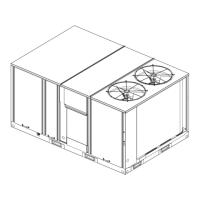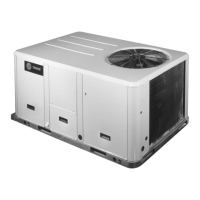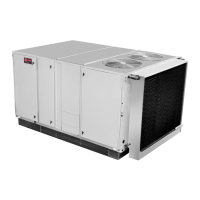36 RT-SVX25Q-EN
Pre Start
Test Modes
There are three methods in which the “Test” mode can be
cycled at LTB-Test 1 and LTB-Test 2.
1. Step Test Mode—This method initiates the different
comp
onents of the unit, one at a time, by temporarily
shorting across the two test terminals for two to three
seconds.
For the initial start-up of the unit, this method allows
the
technician to cycle a com
ponent “On” and have up
to one hour to complete the check.
2. Resistance Test Mode—This method can be used for
start-up provi
ding a decade box for variable resistance
outputs is available. This method initiates the different
components of the unit, one at a time, when a specific
resistance value is placed across the two test
terminals. The unit will remain in the specific test mode
for approximately one hour even though the
resistance is left on the test terminals.
3. Auto Test Mode—This method is not recommended
for
start-up due to the short timing between in
dividual
component steps. This method initiates the different
components of the unit, one at a time, when a jumper
is installed across the test terminals. The unit will start
the first test step and change to the next step every
30 seconds. At the end of the test mo
de, control of th
e
unit will automatically revert to the applied “System”
control method.
For unit test steps, test modes, and step
resistance values
to cycle the various components, refer to Table 8.
Table 8. Service test guide for component operation
TEST
STEP MODE Fan Econ
(a)
(a) The exhaust fan will turn on anytime the economizer damper position
is equal
Comp
1
Comp
2
Heat
1
Heat
2 Ohm
1
Fan On
Minimum
Posit
ion
Setpoint
0%
Off Off Off Off 2.2K
Minimum
Ve
nti
lation
On
Select-
able
Off Off Off Off
2
Economizer
Tes t O
pe n
On Open Off Off Off Off 3.3K
3
Cool Stage
1
On
Minimum
Posit
ion
On
(b)
(b) The condenser fans will operate any time a compressor is “On.”
Off Off Off 4.7K
4
(c)
(c) Steps for optional accessories and non-applicable modes in unit will be
skipped.
Cool Stage
2
On
Minimum
Position
On(b) On(b) Off Off 6.8K
5(c) Reheat On Minimum On On Off Off 33K
6(c)
Heat Stage
1
On Minimum Off Off On Off 10K
7(c)
Heat Stage
2
On Minimum Off Off On On 15K
Verifying Proper Air Flow (Units
with Belt Drive Indoor Fan)
Much of the systems performance and reliability is closely
associated with, and dependent upon having the proper
airflow supplied both to the space that is being
conditioned and across the evaporator coil.
The indoor fan speed is changed by opening or closing the
adjustable mo
tor sheave.
Before starting the SERVICE TEST, set th
e minimum
position setpoint for the economizer to 0% using the
setpoint potentiometer located on the Economizer Control
(ECA), if applicable.
ReliaTel Control
Using the Service Test Guide in Table 8, momentarily jump
across the Test 1 and Test 2 terminals on LTB1 one time to
start the Minimum Ventilation Test.
Once the supply fan has started, check for p
roper rotation.
The direction of rotation is indicated by an arrow on the fan
housing.
With the fan operating properly, determine the total
system airflow (cfm):
1
. Measure the actual rpm.
2. Measure the amperage at the su
pply fan co
ntactor and
compare it with the full load amp (FLA) rating stamped
on the motor nameplate.
a. Calculate the theoretical bhp:
Actual Motor Amps
X Motor HP
Motor Nameplate Amps
b. Using the fan performance tables in the unit Service
Facts, plot the actual rpm (Step 1) and the bhp (Step
2a) to obtain the operating cfm.
3. If the required cfm is too low, (external static pressure
is high
causing motor horsepower output to be below
table value):
a. Relieve supply and/or return duct static.
b. Change indoor fan speed and repeat Step 1 and
Step 2.
4. To increase fan rpm, loosen th
e pul
ley adjustment set
screw and turn sheave clockwise.
5. To decrease fan rpm, loosen the pulley
adjustment
set
screw and turn sheave counterclockwise.
6. If the required cfm is too high, (external static pressure
is lo
w causing motor horsepower output to be above
table value), change indoor fan speed and repeat Step
1 and Step 2.

